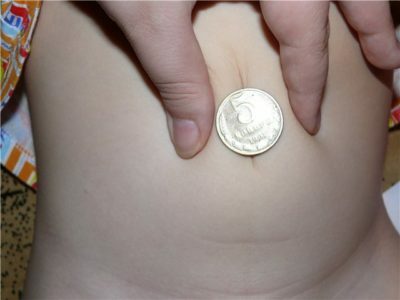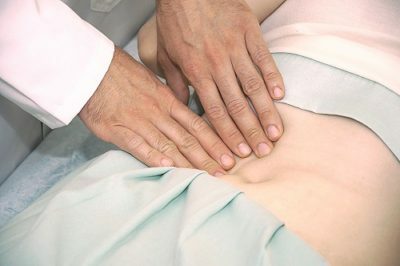1 Symptoms of the disease
When talking about what symptoms indicate a postoperative hernia, then these are, first and foremost, a characteristic bulge in the scar area left after surgery and on both sides of it. The protrusion can be almost imperceptible or very significant in its size.

Recommended to consult
- Symptoms and treatment of umbilical hernia in adults
- What is the adhesions after operation
- What are the manifestations of hernia of the esophagus
- Effective agent for gastritis and stomach ulcer
At an early stage, the postoperative hernia can be fixed without special problems, especially if it is smallon the sizes and does not deliver to the patient of strong inconveniences. But with sudden movements, and lifting the weight or straining hernia will bulge, causing pain.
If you do not take action, the attacks of pain will intensify.
In addition to bouts of patient's pain, symptoms such as bloating and constipation, unpleasant eructations and nausea, loss of appetite. In the area of protrusion of the hernia, reddening of the skin, irritation and inflammation can be observed. In case of complications, vomiting and the presence of blood clots in feces and urine, excessive gas formation are possible.

2 Causes of pathology
Postoperative hernias can arise due to various reasons, among which physicians most often distinguish such:
- The mistake of doctors, which was allowed during surgical intervention and subsequent suturing, is incorrectly selected sutures, illiterate incisions and procedures forstitching of tissues, which weaken the muscles of the peritoneum and lead to the formation of a hernia.
- Inflammation and subsequent suppuration of the wound - the infection can be recorded during an operative intervention or in the conduct of poor-quality post-operative treatment of the sutures.
- The seam after surgery is sewn with poor-quality material, or the seams are misplaced - this leads to the fact that they can disperse.
- Great physical activity during the postoperative period and during rehabilitation.
- Atrophic processes affecting the muscles of the walls of the peritoneum and reducing immunity.
- Obesity and the presence of diseases such as diabetes mellitus and problems with the respiratory system.
- Chronic constipation, when the patient begins to stiffen heavily.
- Severe coughing and vomiting, when a certain muscle group is strained by the patient and, accordingly, not only the hernia may protrude, but also the seam may diverge.
- Chronic diseases of the connective tissue type, in which, by their altered structure, the latter simply can not hold internal organs inside the peritoneum.
-
 IMPORTANT TO KNOW! Gastritis? Ulcer? To have a stomach ulcer not turned into cancer, drink a glass. ..Read the article & gt; & gt;
IMPORTANT TO KNOW! Gastritis? Ulcer? To have a stomach ulcer not turned into cancer, drink a glass. ..Read the article & gt; & gt;
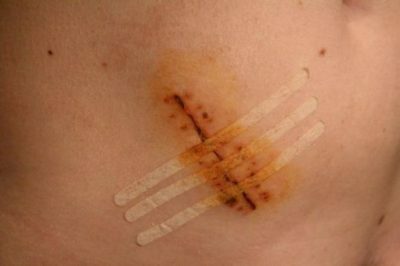
The reasons for the protrusion of the hernia are also very common, and in the case of inadequate preparation for surgery, especially if the latter was conducted in an emergency mode. Most often this concerns the operations on the appendix - a hernia after appendicitis appears according to statistics in half of the patients, when the removal of the process must be done without delay. Such negligence is the main reason for the development of postoperative hernias.
3 Classification of the disease
Before the treatment is appointed, it is necessary to classify the hernia: each of the species has its own characteristics and characteristics.
- According to clinical signs, the hernia is conventionally divided into irreparable and irreplaceable, consisting of one chamber or several, multiple hernias, as well as strangulated and perforated.
- By location - a lateral hernia, located on the right or left side, where there is a postoperative suture, or a medial hernia.
-
 Gastroenterologist VAZHENOV: "I beg you, if you began to worry about abdominal pain, heartburn, nausea, do not in any way do gases. .."Read more & gt; & gt;
Gastroenterologist VAZHENOV: "I beg you, if you began to worry about abdominal pain, heartburn, nausea, do not in any way do gases. .."Read more & gt; & gt;

If to consider the size( width of the hernia gates), the postoperative hernia is divided by the physicians into:
- Small hernia, up to 4 cm, which can only be revealed by palpation - the protrusion itself can manifest anywhere in the peritoneum and does not lead to the stomach changingshape.
- The average hernia, whose width can vary from 4 to 15 cm - this protrusion is very noticeable even to the naked eye and can arise in any area of the abdominal cavity.
- Extensive hernia, the size of which can reach from 25 to 35 cm, leading to deformation of the peritoneum, abdomen, occupying a certain area of the peritoneal wall.
- Giant hernia, the size of which can be more than 40 cm, can spread directly to several areas of the peritoneum, leading to significant deformities of the abdomen, preventing proper walking and movement.
According to the presence of recurrence, the hernia is conventionally divided into primary and recurrent when the new formation occurs repeatedly at the same point.
When talking about what complications post-operative hernia can carry, the patient should be prepared for such unpleasant phenomena as infringement when the peritoneum contents are squeezed in the hernia gates. In addition, there is stasis of feces in the colon and, accordingly, the development of constipation and intoxication of the whole body, a malfunction in the normal functioning of the digestive tract and problems with breathing.
ADVICE FROM THE MAIN GASTROENTEROLOGIST
Korotov SV: "I can recommend only one remedy for the rapid treatment of Ulcer and Gastritis, which is now recommended by the Ministry of Health. .." Read testimonials & gt; & gt;
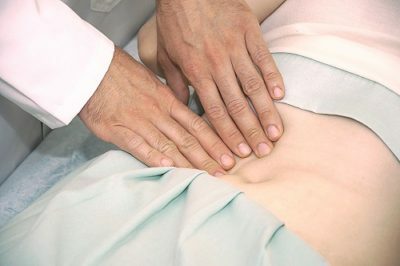
4 Treatment measures
When all signs of a hernia are diagnosed, treatment of the pathology should be carried out immediately. Conservative treatment of a hernia is possible only if there are contraindications for surgical intervention. In the framework of conservative tactics, the patient is shown to follow a diet and exclude any physical effort, to fight with constipation, using an effective laxative, and to wear a special supporting bandage.
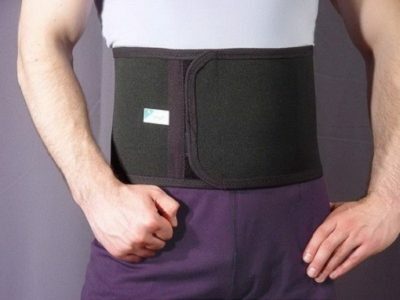
Speaking about the radical method of treatment, in the fight against hernia doctors apply surgical intervention - it is about the use of hernioplasics. In practice, one of three types of surgical intervention is used to eliminate hernia.
- Application of tension plastics.
This surgical procedure is prescribed and performed with small defects, when there are minor protrusions of the hernia. In this case, the surgeon uses the patient's own tissues to repair the defect - they are stitched together on top of the formed protrusion. Apply this method is rare - the fact is, in the process of conducting an operation, the breathing process can be disrupted, as an option - the repeated occurrence of scars.
WE RECOMMEND!
For prophylaxis and treatment of Digestive Gastrointestinal Diseases our readers advise Monastic tea. This unique remedy consists of 9 medicinal herbs useful for digestion, which not only complement, but also enhance each other's actions. Monastic tea will not only eliminate all symptoms of the gastrointestinal tract and digestive system, but will also permanently eliminate the cause of its occurrence.
Opinion of doctors. .. »
- Implantation of a reticular implant - this is how the hernia and its protrusion on the abdominal cavity are most often eliminated.
In this case, the surgeon inserts a special implant in the surgical procedure in the form of a mesh - a patch that is sewn to the tissues located near the protrusion. Such a prosthesis is made of polypropylene - it quickly grows alive tissue, preventing subsequent protrusions.
- Laparoscopic hernioplasty.
The most common technique is when small incisions are made in the abdominal cavity and an endoprosthesis in the form of a mesh with a special coating is already applied to the hernial gates.
5 Surgical method
As a result of surgical intervention, it is possible not only to eliminate protrusion, but also to correct postoperative scars, thereby improving the appearance of the peritoneum. In addition, negative symptoms are removed in the form of bouts of pain and disturbance during movement, and further complications are prevented.

After the operation, the patient has a specific time - from 1 day to a week - in the medical institution, depending on the complexity of the surgery.
6 Preventive measures
After performing surgical intervention to eliminate hernia, the patient is recommended to follow certain preventive measures that will promote a speedy recovery and prevention of recurrence.
At the very beginning it is necessary to empty the bowels regularly - not to restrain yourself and at the first urge to visit the toilet, and when constipation occurs, take medications that promote soft emptying of the intestine. In the postoperative period, it is recommended not only to wear a bandage, but also to observe a strict diet prescribed by the attending physician, to eliminate any stresses and physical activity.
No less important point, as it was said before, is the wearing of a special bandage that will not strain the muscles, relieve the strain and accelerate the process of tissue coalescence, plus strict adherence to all prescriptions of physicians.
- 1 Symptoms of the disease
- 2 Causes of the pathology
- 3 Classification of the disease
- 4 Treatment measures
- 5 Surgical method
- 6 Preventative measures
Postoperative hernia is a pathological form of protrusion of the internal organs of the peritoneum due to a defect that forms in the area of the scar left after the operation. Postoperative hernia of the abdominal cavity may occur as a week after the operation, and after a few years.
By itself, pathology is quite a dangerous phenomenon, requiring immediate attention to specialists and surgical intervention. Otherwise, the patient will not only be difficult to breathe or move, but the risk of peritonitis and disability increases.
Do you have gastritis?
GALINA SAVINA: "How easy is it to cure gastritis at home for 1 month. A proven method - write down a recipe. ..!"Read more & gt; & gt;

